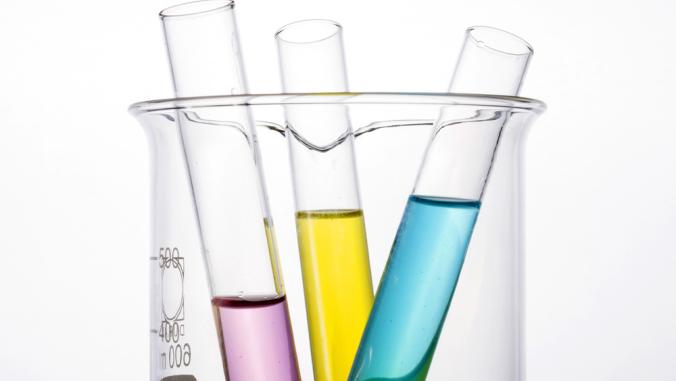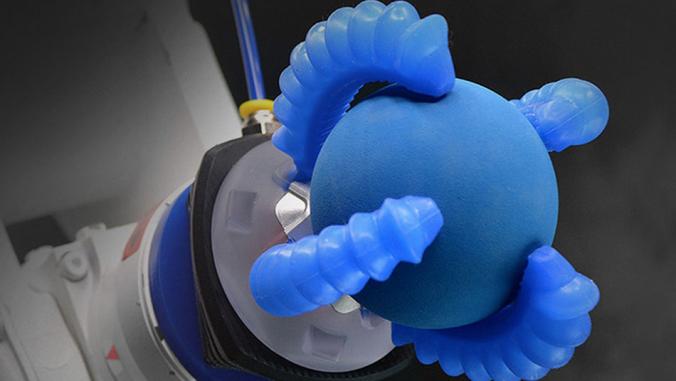The Year in Biomimicry: How Beetles, Mantis Shrimp & More Inspired Innovation
<p>It's time for the third annual Tommies, Tom McKeag's pick of the top 10 bio-inspired innovations of 2011 -- and a look at the lessons that Namib desert beetles, crickets, Mantis Shrimp and more can teach us about sustainability.</p>

Yes, it's that time of year again: Time for the third annual Tommies, my pick of the top 10 bio-inspired innovations of 2011.
My prize offer to any of the innovators still stands: Have an Irish coffee with me at the Buena Vista in San Francisco.
Here are the inventions or discoveries arranged by the organisms that inspired them:
1. Herring Gull. This long-lived coastal bird is a common sight along the entire shore of western and northern Europe. Our familiarity with its appearance, however, cannot mask our wonder at its aerial acrobatics. The bird is a consummate flyer and had inspired the volken at the Bionic Learning Network of Festo AG and Co. of Germany to accomplish another impressive feat of bio-inspired engineering.
SmartBird is a 485 gram construction of foam plastic and carbon fiber, a few servomotors, gears and linkages that accomplishes something man has tried and failed at for centuries -- heavier than air flight that truly mimics the biomechanics of birds.
This device gains both thrust and lift from the flapping of flexible two-part wings, a concept that aeronautic engineers had abandoned in frustration long ago.
The design team, led by Markus Fischer and Wolfgang Send, claims that the device achieves an 80 percent aerodynamic efficiency and is able to maintain optimum airflow through its sophisticated software control system and the active torsion in its wing surfaces. The bending of its wing surfaces is precisely coordinated with the flapping of the wings to produce this milestone in both biomimetics and aeronautics.
This breakthrough was gained through a combination of intense study of the mechanics of bird flight, an informed translation to the optimum materials available and an understanding that a precise integration of forces was necessary to mimic the complex sensing and movement needed to maintain airflow over an active wing.
2. Pitcher Plant. This swamp-dwelling plant lives in soil conditions that are nutrient poor and has evolved to get its daily requirements in another way -- by putting meat on the menu. It captures insects by trapping them in its watery bowl where they are dissolved and absorbed by the plant. The lipped bowl, a modified leaf, is effective, in part, because of its ultra slippery surface.
The scientists at the Aizenberg Lab of the Wyss Institute for Biologically Inspired Engineering at Harvard were looking for a slick natural surface material and the Pitcher Plant emerged as their top candidate for study. Their initial goal was to synthesize a material that was "omniphobic," that repelled everything.
Research by Bohn and Federle in 2004, had revealed the unique properties of the plant's peristome, the rounded lip of the "bowl." Overlapping wet cells formed anisotropic ridges in which an aqueous solution was held in surface tension as a thin film. The edge formed, in effect, a tiny Slip'N Slide, and even ants, with their suction-cup footpads, could not get a grip on the surface and would aquaplane to their doom.
The Harvard team needed to produce a structure that was fully wetted by lubricating liquid, this material must prefer to retain this liquid over any other that was poured on it, and both liquids must be immiscible, in other words, not able to be blended. They fabricated a random matrix of Teflon nanofibers that they filled with a low-tension perfluorinated proprietary liquid from 3M (Fluorinet FC-70) .
They have called their product SLIPS ( Slippery Liquid Infused Porous Surface), and it does, indeed, appear to repel everything: -- blood, oil, even ice cannot form on its surface. Things slip off at a mere 2-degree angle and liquids that would stain other slippery surfaces completely exit the surface. What they have won is the product development trifecta: the new material is not only self-cleaning, but also self -healing and self- organizing. When cuts are made in the structural matrix, the liquid quickly fills the gaps and the slippery surface performance continues unabated.
Lead researcher Tak Sing Wong reports the new biomaterial has performed well at low temperatures and high pressures and he believes it to be more slippery than Teflon, the reigning slick solid of our industrial world. It would be useful for a range of biomedical, industrial and other applications, such as pipe coatings, self-cleaning public surfaces and de-icing applications. Not the least, its transparency potential and self-cleaning make it an excellent choice for lenses, sensors and solar cells.
The nature inspired innovators here turned a problem inside out. How to make a slippery surface? First, consider that not all surfaces are solid. Indeed, as far as performance goes, the material structure of the plant is more important for its voids than for its solid matrix, for it is the liquid that does the work of sliding insects to the waiting bowl. Once this became the contact material, the liquid medium brought additional characteristics: liquids typically organize themselves by molecular bonding, and they can fill gaps in solids automatically, thus adding the benefits of self-organizing and self-healing. This is an excellent example of "surfing for free" where devices take advantage of natural physical, material or structural properties in order to do work.
3. Homo Sapiens. There are at least 10 different types of eye mechanisms in the animal world, and the device that humans possess is a wonder of evolutionary engineering. We are able to focus our eyes automatically to a wide range of distances, even while running. Cillary muscles surrounding the crystalline lens contract and relax as needed to deform the lens of our eye for the different focal lengths needed.
Just such a "tunable" lens would be very useful in the fields of consumer electronics, medical diagnostics and optical communications. Much research has been done on artificial lenses and their actuators; smart devices that are triggered by mechanical, optical, electrical, thermal or chemical means.
Professor Danilo De Rossi and his team at the School of Engineering, University of Pisa, have devised a tunable lens using an electroactive elastomer as an artificial muscle, much like in the human eye. A fluid-filled elastomeric lens is integrated with a ring of dielectric elastomeric actuator. Upon electrical activation or deactivation, the actuator relaxes or stretches the lens, changing the focal length. The De Rossi team has been able to replicate the focal range of the human eye using this synthesized device. The potential benefits lie in its silent operation, low power usage, relative durability and resistance to shock and overheating.
The bio-innovation concept here is substituting information for material or energy. In this case, the information is embedded in the elastomeric material. Its properties allow a consistent and predictable range of performance once triggered by a tiny electrical charge. Simple, lightweight and durable parts and systems save money, and nature has a lot to teach us on this score.
4. Namib Desert Beetle. Oh my gosh, a repeat winner! This animal is able to wring moisture out of the night air of the desert in order to survive. It does so by facing into the prevailing sea breeze and letting its cooler body condense small droplets of water that run down channels to its waiting mouth. The droplet formation is ensured by a clever series of hydrophilic bumps surrounded by hydrophobic parts of its shell.
The creature has inspired yet another invention created to solve our increasing scarcity of potable water. James Dyson award-winner Edward Linacre of Swinburne University in Melbourne, Australia, has designed the Airdrop water harvester as a simple integrated system to provide water to crops in arid regions. It comprises a collector, condenser, storage tank and underground drip irrigation distribution network, and is easily installed and maintained by the farmer.
Like its biological mentor the Airdrop makes use of a difference in surface temperature to force the condensation of water vapor, but it uses the soil underground to do it. The subterranean coiled copper pipe forces the dew point in air collected via turbine and the water drops below into a tank from whence it is pumped to the crops. An LCD screen displays tank water levels, pressure strength, solar-battery life, and system health. Linacre estimates that 11.5 milliliters of water can be extracted from every cubic meter of air.
The innovation here is most decidedly in the thoughtful application of a physical principle that creatures take advantage of, namely the temperature activated phase change of water. And why shouldn't we?
5. Caterpillar. Many of these invertebrates employ a hoop-forming locomotion tactic in order to escape predation and biologists and mechanical engineers at Tufts University studied this behavior in designing GoQBot. Huai-Ti Lin, who designed the GoQBot, claims that this escape motion is one of the fastest self-propelled wheeling behaviors in nature, and it piqued his interest in its study.
The result was a 4-inch long robot made of silicone rubber, with actuators that are made of embedded shape-memory alloy coils. In tests at the lab the robot achieved a push-off time of less than 250 milliseconds and spun with an angular velocity of 300 rpm. The intriguing aspect of this innovation is that it suggests multiple forms of locomotion from the same device. Previous robots inspired by snakes have been highly articulated and flexible, but notoriously slow. This device suggests the possibility of creating an unmanned vehicle that can alternately move in tight spaces, span gaps and move with speed.
Here is a video of the GoQBot posted by the Institute of Physics. video:
Nature does not employ too many wheels (ATP synthase, and the rotary base of certain bacteria flagella come to mind), so this innovation is especially novel in its biological approach. This fresh look has enabled multiple functions not previously achieved, and represents another step in the path toward more and more capable "softbots."
6. Cricket. If you think the sound of crickets is an essential part of any romantic summer evening, you have good reason. Male crickets are trying to attract females by a species-specific chirp at a fixed frequency of about 4.5 kHz. But how do the females find them once they hear the call?
Female crickets are equipped with special receptors or tympani on their front legs that are used to compare the pressure fluctuations between right and left sides of the animal. The pressure is carried up into the cricket by means of auditory trachea. Pressure fluctuations reach each tympanum directly as well as indirectly, from the other side of the body. Phase shifts between these two sources strongly modulate the tympanum-oscillations and allow the female to determine the direction of the source of potential romance.
Crickets also have many tiny hairs or cerci along their abdomens that measure pressure fluctuations and scientists believe their purpose is to sense attacks. The sensitivity and precision of these hairs are remarkable, and inspired a research group from the University of Twente in the Netherlands to mimic their operation.
The team was part of CICADA, a European Union project aimed at developing a bio-inspired perception system. They attached hundreds of 0.9 millimeter long plastic wires to sockets in silicon wafer sheets to form a receptor array. The wires rotate in their sockets as they are moved by minute air pressures and the smallest movements are registered by the flexibly-suspended plate. The electrical capacity of the plate changes as a result and this measure is fed into a central computer.
Further refinement allowed measurement at an even finer level of precision. Harmen Droogendijk discovered that it was possible to adjust the spring stiffness of the wires electronically. He investigated the alternating voltage needed to relax each wire at the required moment, enabling it to be extra sensitive to the related frequencies. The effect was significant and increased sensitivity at the adjusted frequency tenfold.
Gijs Krijnen, the physicist who led the project with colleague Remco Wiegerink, believes that their device will be a useful prototype for technologies like hearing aids and sensors as well as measuring devices for airflow in aeronautics. Indeed, the device already reaches levels of precision in measuring air pressure and particle velocity previously unmatched, according to Krijnen.
The innovation here is an example of successful scale change and use of modularity in order to improve an existing technology. The exploration of nature at the micro scale has informed the improvement and it has the potential for creating a new paradigm for sensing in several different technologies.
7. Mantis Shrimp. This crustacean has compound eyes that can distinguish between left- and right-circularly polarized light.
Polarization is the changing of the orientation of a light ray's oscillations. All light rays are examples of electromagnetic radiation and, as such, radiation is emitted in all directions out the "sides" from the direction of travel of the wave. Polarizing sunglasses block some of this radiation traveling in certain planes, and therefore cut out glare.
Many animals can see polarized light, including ants, bees, fruit flies and some fish. Humans, typically, cannot. It's not known why the Mantis Shrimp has evolved this extraordinary capability, but secret signaling and better underwater vision are possibilities.
The shrimp has an array of tiny hairlike folds, or microvilli, within a light-sensitive cell of each eyelet that functions as a quarter waveplate. Waveplates refract light and change the frequency of emitted wavelengths. A quarter waveplate creates a quarter-wavelength phase shift.
The membrane of every microvillus in the light-sensitive cell is made of a birefringent material. This means that light is doubly refracted by this material and, because the microvilli are arrayed in parallel ranks in diameters smaller than the wavelengths found in light, the rays finally emitted are not predisposed to one color or another. This capability makes it possible for Mantis Shrimps to convert linearly polarized light to circularly polarized light and vice versa.
This so-called "achromatic phase retardation," or wavelength-independent phase shift, achievable over the broad visible spectrum, is a very big deal within the optical technology sector; in display technologies, communications systems, and optical pick-up systems. Manmade quarter-wave plates perform this essential function in CD and DVD players and in circular polarizing filters for cameras, for example. They are limited, however, to a narrow wavelength range (certain colors), which is why mimicking the Mantis Shrimp is useful. Since the discovery of this natural waveplate by a team from the University of Bristol in Britain in 2009, many have been working on perfecting its synthetic version.
One such team, from National Taipei University of Technology in Taiwan, and Pennsylvania State University in the United States, has reported encouraging results in this synthesis. They have constructed an array of vertical nanorods made from alternating thin films of different refractive properties. This array mimics the two types of birefringence found in the Mantis Shrimp eyes. The films were laid down using a well-known process, the Oblique Angle Deposition (OAD) method. They claim that their methodology can be applied to design a waveplate for any wavelength range.
The innovation here is one of expanding the capabilities of current technology using a model from nature (widening the wavelength range of optical devices), and perfecting the methods and materials needed for more efficient manufacture (thin film deposition). Although the reason for the shrimp's optical capabilities are still a bit of a mystery, their usefulness is not and this is a very good example of making the inspirational practical.
8. Plant Kingdom. Vascular plants transport water through their roots, shoots and leaves by means of a passive pumping system that is driven by the transpiration of water from the stomata of the plant's leaves.
In transpiration, water vapor is drawn from the leaf interior down a water potential gradient toward the outside air, much as a dry towel will wick away water from your skin.
This action powers water transport, but the cohesion of the water itself and its adhesion to the sides of the xylem in the plant is what helps water columns over 100 meters high defy the forces of gravity. In this mechanism there is an unbroken chain of hydrogen-bonded water molecules from the roots to the topmost leaves.
Researchers from Dalian University of Technology in China, have developed a micropump based on the principle of stomatal transpiration. Since flow rates based on micropore transpiration far exceed that of simple evaporation, the team used this "diameter law" to make a layered membrane with controllable micropores.
The micropump works on the principle of diffusion mentioned above and therefore requires no external energy to operate. It comprises three layers: the top layer is a 93 μm-thick PVC (polyvinylchloride) film with a group of slit-like micropores; the second layer is a PMMA (poly(methyl methacrylate)) sheet with adhesives to join the other two layers together; the third layer is a microporous membrane. Flow rates were controlled by the opening and closing of some of the micropores, and were both high and adjustable. Its simple structure, low fabrication cost and independence from a power source make it widely applicable to medical and manufacturing situations requiring quick, on-the-spot fluid pumping.
This is another great example of "surfing for free." Investigators have abstracted the principles of transpiration in order to construct a pump that is powered by the physical forces inherent in the material being manipulated. in this case, the tendency of fluids to flow from areas of high concentration to low.
9. Eukaryotes. Our living world can be divided into two basic cell types, Prokaryotes ("primitive" bacteria) and Eukaryotes (everything else).
Cilia, or tiny hairs, exist in many forms in the Eukaryotic world, including in our own windpipes, where they help sweep debris out of our lungs, and women's oviducts, where they help move the egg to the uterus. The cross-section of these hairs, whether on a protozoan membrane or in our windpipes, is remarkably similar.
Cilia are very handy to have. They sweep back and forth and either propel something, oarlike, through a fluid, or move loose material along their surface. They can also filter, and, of course, sense things; thanks, in no small part, to their high aspect ratio. Like all modular parts in nature, they get a lot done through strength of numbers, and damage to any one hair does not impede general operations.
Philseok Kim of the Wyss Institute for Biologically Inspired Engineering at Harvard, has designed a biomimetic system in which synthetic cilia are embedded in a hydrogel.
Hydrogels are water-loving mixtures of polymers and water that have a high shrink-swell capacity. The hydrogel can be made to respond to several different external stimuli and serve as an adjustable substrate for the cilia, causing them to project or to lie flat.
Indeed, hydrogels can be programmed into topographical patterns as intricate as opening and closing microflorets by controlling the volume and the conformation of the gel. The synthetic cilia are typically silicon nanostructures that have been created by the Bosch etching method, and these, too, have a multitude of patterns and characteristics possible.
Kim has proposed that these structures could be used as smart building membranes activated by temperature in order to improve energy efficiency. When building surfaces reached a temperature threshold, the transparent hydrogel would deploy the hairs on end. Each hair would possess a tiny deformable micromirror that would present its face to the exterior. Like the crowd at a football game that spells out messages in mosaic, the mirrors would form a continuous flat surface. This surface could now be tuned to control light and heat into the building.
There are scores of other potential applications for this technology, wherever dynamic, responsive surfaces would improve our lives. These include interior pipe surfaces that adjust flow characteristics according to the chemical composition of the liquid within them, fabric that can reverse its wetting properties, or structural members that change color according to the mechanical stress placed upon them. With the environmentally activated hydrogel as the engine and the nanostructure array as the translator of energy into mechanical work (and both separately programmable) there are many degrees of freedom in this system.
The bio-innovations here are many. The groundbreaking combination of two materials from separate research areas in order to solve problem contradictions is one. The hybrid system takes the best in tunability, responsiveness and reversibility from the hydrogel, and the range of mechanical behavior from the nanowires. Moreover, research into fabrication has made the flexible (hydrogel) more structured, and the rigid (nanostructure) more dynamic. This system also exhibits several other principles of bio-inspired design: Little things multiply up (emergence), surfing for free, and the use of a hierarchy of scales to solve a problem.
10. Animal Kingdom. Blood circulation systems in animals do many things -- distribute nutrients and enzymes, exchange oxygen and carbon dioxide, and regulate temperature, to name a few.
These circulatory systems also transport repair materials to wounds. When you cut yourself, platelets in your blood and the blood-clotting protein fibrinogen form a meshwork that traps red blood cells. Tissue-forming fibroblast cells collect in the area and white cells called neutrophils ingest the cell debris and foreign matter like dirt and germs. The clot gradually hardens to become a scab as the tissues heal beneath.
Self-healing materials is a major area of bio-inspired research, and there are many different approaches to the challenge, at the molecular, micro and macro levels. One macroscale approach has been pioneered by Professor Nancy Sottos and her team at the University of Illinois Urbana-Champaign. It involves the impregnation of plastics with a fine network of channels, each less than 100 millionths of a meter in diameter, that can be filled with liquid resins. These "micro-vascular" networks penetrate the material like an animal's circulation system, supplying healing agent to all areas, ready to be released whenever and wherever a crack appears.
The resins in the channels are placed under pressure and when a crack crosses a channel the liquid is drawn into the void and followed by a hardener. The pressurized system is an improvement over previous work that relied on embedded micro capsules of resin that were burst at the outset of a crack. The supply of repair material was too small and the reliance on diffusion alone too slow. The pumping system now allows for the repair of cracks up to a millimeter across, a tenfold increase.
Applications include the self-repair of vehicles and structures, and further refinements would include the integration of the pumping system into the material itself and increasing the multi-functionality of this synthetic vascular system, say making it do extra work as a hydraulic structural support system.
Congratulations to all our winning creatures! May we have the wisdom to use your lessons well.
CC-licensed photo at top of page of mantis shrimp via Wikimedia Commons.





